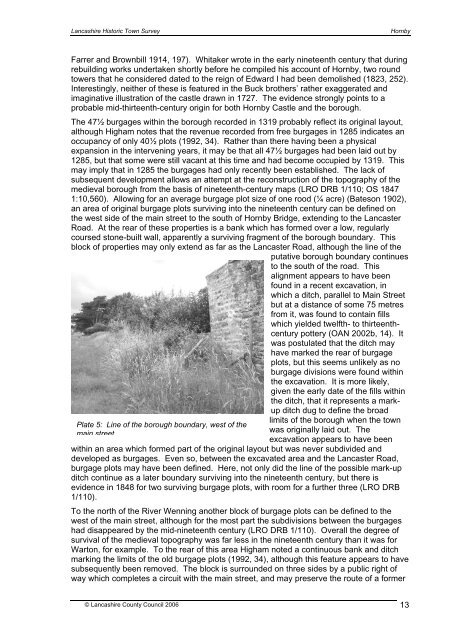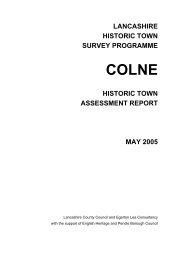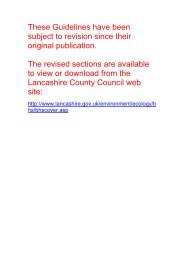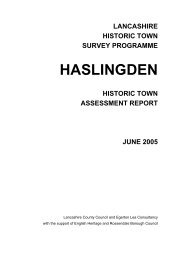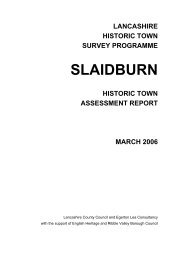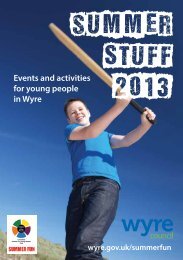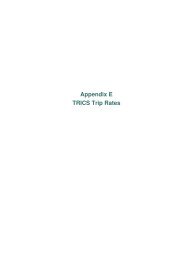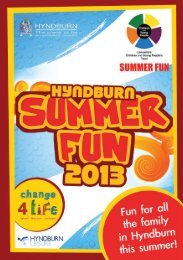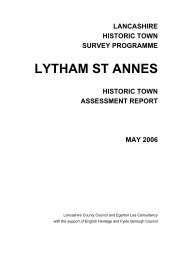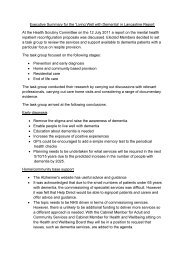HORNBY - Lancashire County Council
HORNBY - Lancashire County Council
HORNBY - Lancashire County Council
Create successful ePaper yourself
Turn your PDF publications into a flip-book with our unique Google optimized e-Paper software.
<strong>Lancashire</strong> Historic Town SurveyHornbyFarrer and Brownbill 1914, 197). Whitaker wrote in the early nineteenth century that duringrebuilding works undertaken shortly before he compiled his account of Hornby, two roundtowers that he considered dated to the reign of Edward I had been demolished (1823, 252).Interestingly, neither of these is featured in the Buck brothers’ rather exaggerated andimaginative illustration of the castle drawn in 1727. The evidence strongly points to aprobable mid-thirteenth-century origin for both Hornby Castle and the borough.The 47½ burgages within the borough recorded in 1319 probably reflect its original layout,although Higham notes that the revenue recorded from free burgages in 1285 indicates anoccupancy of only 40½ plots (1992, 34). Rather than there having been a physicalexpansion in the intervening years, it may be that all 47½ burgages had been laid out by1285, but that some were still vacant at this time and had become occupied by 1319. Thismay imply that in 1285 the burgages had only recently been established. The lack ofsubsequent development allows an attempt at the reconstruction of the topography of themedieval borough from the basis of nineteenth-century maps (LRO DRB 1/110; OS 18471:10,560). Allowing for an average burgage plot size of one rood (¼ acre) (Bateson 1902),an area of original burgage plots surviving into the nineteenth century can be defined onthe west side of the main street to the south of Hornby Bridge, extending to the LancasterRoad. At the rear of these properties is a bank which has formed over a low, regularlycoursed stone-built wall, apparently a surviving fragment of the borough boundary. Thisblock of properties may only extend as far as the Lancaster Road, although the line of theputative borough boundary continuesto the south of the road. Thisalignment appears to have beenfound in a recent excavation, inwhich a ditch, parallel to Main Streetbut at a distance of some 75 metresfrom it, was found to contain fillswhich yielded twelfth- to thirteenthcenturypottery (OAN 2002b, 14). Itwas postulated that the ditch mayhave marked the rear of burgageplots, but this seems unlikely as noburgage divisions were found withinthe excavation. It is more likely,given the early date of the fills withinthe ditch, that it represents a markupditch dug to define the broadPlate 5: Line of the borough boundary, west of themain streetlimits of the borough when the townwas originally laid out. Theexcavation appears to have beenwithin an area which formed part of the original layout but was never subdivided anddeveloped as burgages. Even so, between the excavated area and the Lancaster Road,burgage plots may have been defined. Here, not only did the line of the possible mark-upditch continue as a later boundary surviving into the nineteenth century, but there isevidence in 1848 for two surviving burgage plots, with room for a further three (LRO DRB1/110).To the north of the River Wenning another block of burgage plots can be defined to thewest of the main street, although for the most part the subdivisions between the burgageshad disappeared by the mid-nineteenth century (LRO DRB 1/110). Overall the degree ofsurvival of the medieval topography was far less in the nineteenth century than it was forWarton, for example. To the rear of this area Higham noted a continuous bank and ditchmarking the limits of the old burgage plots (1992, 34), although this feature appears to havesubsequently been removed. The block is surrounded on three sides by a public right ofway which completes a circuit with the main street, and may preserve the route of a former© <strong>Lancashire</strong> <strong>County</strong> <strong>Council</strong> 2006 13


